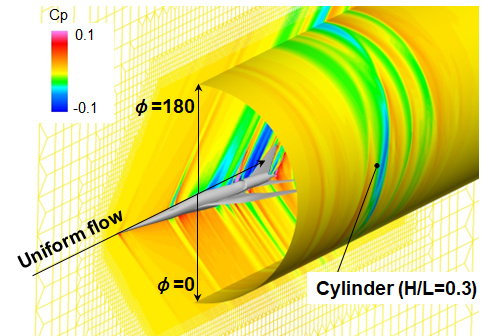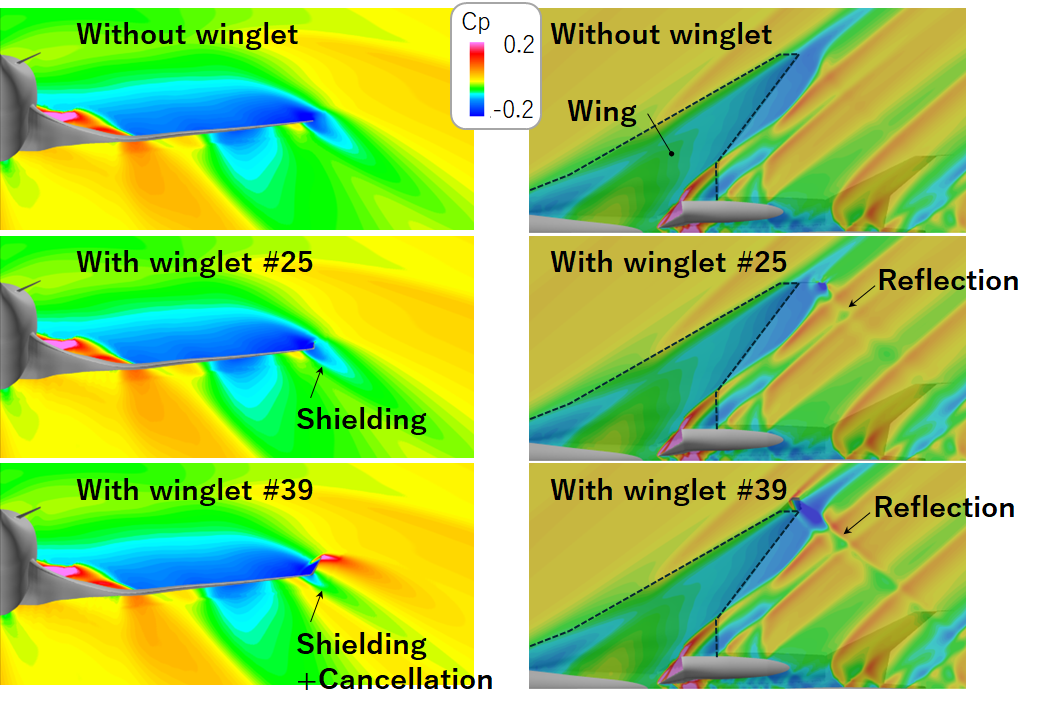Research and development for system integration of silent supersonic airplane technologies
JAXA Supercomputer System Annual Report February 2024-January 2025
Report Number: R24EA3800
Subject Category: Aeronautical Technology
- Responsible Representative: Yoshikazu Makino, Aviation Technology Directorate, Re-BooT Project Team
- Contact Information: Hiroaki Ishikawa(ishikawa.hiroaki2@jaxa.jp)
- Members: Junichi Akatsuka, Hiroaki Ishikawa, Shinya Koganezawa, Masashi Kanamori, Satoshi Kondo, Ryo Shimada, Hajime Miki, Yusuke Naka, Atsushi Shinozuka, Kensuke Soneda, Hisato Takeda, Atsushi Ueno, Tatsunori Yuhara, Hamidreza Kheirandish
Abstract
It is important to acquire world-class high level technology for supersonic transport in order to enhance the international competitiveness of Japan's aircraft manufacturing industry. Supersonic transport allows for shorter travel time, leading to a number of benefits such as revitalization of business and tourism. It also reduces the number of passengers suffering from economy class syndrome. Towards these advantags, the purpose of this project is to acquire the key technologies required for a "quiet supersonic aircraft" and contribute to the development of the aircraft manufacturing industry and air transport in the future. The purpose of this project is to conduct R&D on sonic boom estimation, measurement and evaluation technologies, and to contribute to the development of international standards at ICAO required for over land supersonic flight. The project team has been developing the integrated design technology satisfying low boom, low drag, low noise and weight reduction, and presenting a concept of a supersonic transport that simultaneously satisfies these technical goals.
Reference URL
Please refer to 'Supersonic transport design technologies | Sky Green+ | Research & Development | Aviation Technology Directorate'.
Reasons and benefits of using JAXA Supercomputer System
To develop a future supersonic transport that satisfies the requirement of low sonic-boom and low aerodynamic drag, it is necessary to estimate aerodynamic properties and sonic-boom properties by accurate numerical simulation. JSS is used to estimate aerodynamic performances of various configurations with high accuracy and high efficiency for the designing of the low-boom supersonic transport.
Achievements of the Year
In a low-boom design, an airframe geometry is designed so that an idealized equivalent area distribution can be achieved. For this purpose, a lifting surface such as a fin and a volume such as a bump are additionally designed. These additional low-boom devices increase drag. Therefore, low-drag and low-boom design is required for these devices. In this study, a winglet that is used as a low-drag device at a transonic speed is focused on, and its low-boom and low-drag characteristics are examined by using CFD analysis (Fig. 1). Results show that toe and twist angles should be determined so that expansion waves on a wing upper surface act as a thrust on winglet surface for reducing drag. In terms of sonic boom, a winglet has a shielding, cancellation, and reflection effects shown in Fig. 2. For reducing sonic boom, shielding and cancellation effects are important, and a cant angle along with toe and twist angles mentioned above should be determined to utilize these effects. These results were presented at JSASS 62nd aircraft symposium.
Publications
- Non peer-reviewed papers
Ueno, A. and Yoshikazu, Makino.: Low-boom and low-drag design using winglet, 62nd Aircraft Symposium, 2024.
Usage of JSS
Computational Information
- Process Parallelization Methods: MPI
- Thread Parallelization Methods: Automatic Parallelization
- Number of Processes: 960 - 3840
- Elapsed Time per Case: 100 Hour(s)
JSS3 Resources Used
Fraction of Usage in Total Resources*1(%): 2.18
Details
Please refer to System Configuration of JSS3 for the system configuration and major specifications of JSS3.
| System Name | CPU Resources Used(Core x Hours) | Fraction of Usage*2(%) |
|---|---|---|
| TOKI-SORA | 39733061.62 | 1.82 |
| TOKI-ST | 5240702.00 | 5.38 |
| TOKI-GP | 1529.86 | 0.02 |
| TOKI-XM | 12128.61 | 5.90 |
| TOKI-LM | 64543.62 | 4.66 |
| TOKI-TST | 0.00 | 0.00 |
| TOKI-TGP | 0.00 | 0.00 |
| TOKI-TLM | 0.00 | 0.00 |
| File System Name | Storage Assigned(GiB) | Fraction of Usage*2(%) |
|---|---|---|
| /home | 506.17 | 0.34 |
| /data and /data2 | 38367.18 | 0.18 |
| /ssd | 1004.00 | 0.05 |
| Archiver Name | Storage Used(TiB) | Fraction of Usage*2(%) |
|---|---|---|
| J-SPACE | 22.63 | 0.07 |
*1: Fraction of Usage in Total Resources: Weighted average of three resource types (Computing, File System, and Archiver).
*2: Fraction of Usage:Percentage of usage relative to each resource used in one year.
ISV Software Licenses Used
| ISV Software Licenses Used(Hours) | Fraction of Usage*2(%) | |
|---|---|---|
| ISV Software Licenses(Total) | 11729.58 | 8.01 |
*2: Fraction of Usage:Percentage of usage relative to each resource used in one year.
JAXA Supercomputer System Annual Report February 2024-January 2025




